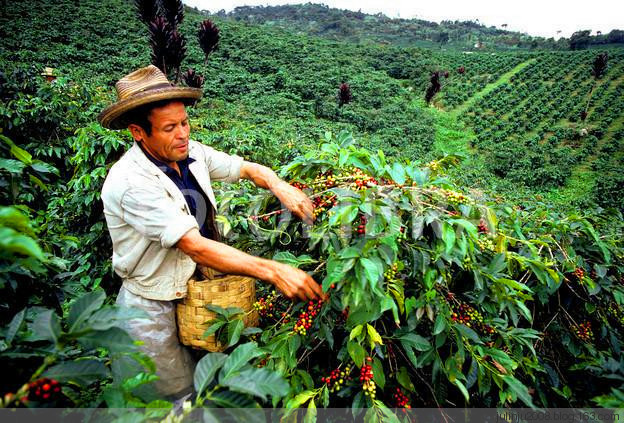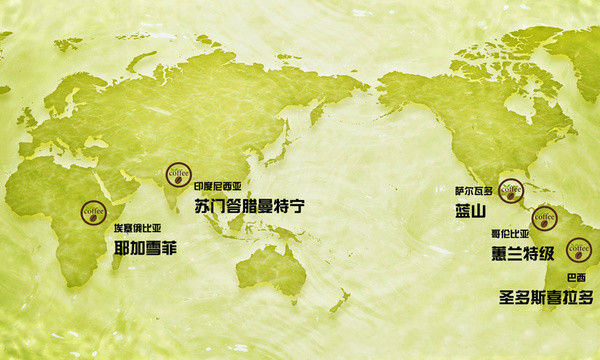The Caesar Louis Manor in Poquet boquete, Panama, washed coffee beans to make coffee coffee.
Choose fresh coffee beans. When buying, pay attention to whether the color of the beans and the size of the particles are the same. Good coffee beans are shiny and have a strong aroma without being mixed with peculiar smell. No matter what kind of coffee beans, freshness is an important factor affecting the quality. When shopping, grab one or two coffee beans in your mouth and chew them with a crisp sound (indicating that the coffee is not damp) and the fragrance of the teeth and cheeks is the top grade, but it is best to squeeze it with your hands to feel whether it is solid, rather than buying crispy coffee. If the coffee bean has lost its fragrance or smells stale, it means that the coffee bean is no longer fresh and is not suitable for purchase.
Freshly fried coffee beans are not suitable for immediate consumption and should be stored for a week to completely release the gas from the beans.
Generally speaking, the best drinking period for coffee is a week after stir-frying, when the coffee beans are the freshest and the Aroma taste is the best.
In addition, the purity of coffee beans is also another consideration. The expert candidate for coffee is not necessarily to look at the size of the particles, but to grab a handful of individual coffee beans (RegionalCoffee), about dozens of portions, to see whether the color of each single bean is the same, and whether the particles are similar in size and shape, so as to avoid buying shoddy products disguised as mixed beans. But if it is a synthetic bean (BlendedCoffee), it is a normal phenomenon that the size and color are different. In addition, heavy heat and medium-deep roasting will cause coffee beans to produce oil, but if the lightly roasted beans produce oil, they have gone bad, not only reducing aroma, but also astringent and sour taste. In short, when buying coffee, we should pay attention to its freshness, aroma and whether it is stale or not, and the ideal purchase quantity is to be able to drink it in half a month. The two coffee bean production methods should first remove the skin, pulp, racing peel and silver skin after harvesting the fruit and before shipping it on the market. There are two kinds of methods: drying (also known as natural or non-washing) and washing.
PanamaBoqueteClassicoEspecial
Country: Panama
Grade: SHB
Region: BaruVolcano Pokuit producing area (Boquete)
Altitude: 1400m
Treatment: washing
Varieties: Kaddura (Caturra) and others
Production: Caesar Louise (CasaRuiz,S.A.)
Flavor: floral aroma, citrus slightly sour, clean and bright taste
Coffee was introduced into Panama in 1780, when Europeans introduced the first Typica tree species. After that, this mysterious and strange drink conquered the senses of Panamanians, and the local people began to grow it widely.
Panamanian Caesar Lois (CasaRuiz,S.A.) Manor, founded in 1920, is located in the Boquete producing area of BaruVolcano Volcano, which is located in the Poquet Valley in the skirt of Baru Volcano in northwestern Panama. Has experienced three generations of coffee planting experience, Caesar Louise (CasaRuiz,S.A.) The family has brought together more than 300 local small family farms and small estate coffee farmers to join partners from planting, reprocessing, baking and marketing, unlike a single manor that cannot increase production scale. The variety of coffee is Typica,Caturra,Catuai,MundoNovoandBourbons. The average annual rainfall is 3000 millimeters (between May and November), the annual average temperature is 14,000 degrees C, and the altitude is more than 1400 meters. Caesar Louise (CasaRuiz,S.A.) The family and his coffee partners chose to follow the Boquete growing area, which is traditionally environmentally friendly and maintains the natural ecosystem, and because the natural trees in the area provide rich natural environmental resources, the environment has become a transit habitat for migratory birds.

Important Notice :
前街咖啡 FrontStreet Coffee has moved to new addredd:
FrontStreet Coffee Address: 315,Donghua East Road,GuangZhou
Tel:020 38364473
- Prev

Class An of PNG Kimmel Manor, Papua New Guinea
Choose fresh coffee beans. When buying, pay attention to whether the color of the beans and the size of the particles are the same. Good coffee beans are shiny and have a strong aroma without being mixed with peculiar smell. No matter what kind of coffee beans, freshness is an important factor affecting the quality. When shopping, grab one or two coffee beans and chew them in your mouth with crisp sound (indicating that the coffee is not damp) and teeth and cheeks.
- Next

Costa Rica Tara Pearl Diamond Villa washing SHB Kaddura how to turn coffee beans into coffee
Choose fresh coffee beans. When buying, pay attention to whether the color of the beans and the size of the particles are the same. Good coffee beans are shiny and have a strong aroma without being mixed with peculiar smell. No matter what kind of coffee beans, freshness is an important factor affecting the quality. When shopping, grab one or two coffee beans and chew them in your mouth with crisp sound (indicating that the coffee is not damp) and teeth and cheeks.
Related
- Guji coffee producing area of Guji, Ethiopia: Humbela, Shakiso, Wulaga
- What is the most expensive variety of Qiloso in BOP multi-variety group?
- How to store the coffee beans bought home?
- Why are Yemeni coffee beans so rare now?
- Ethiopian Sidamo all Red Fruit Sun Sun Santa Vini Coffee beans
- SOE is mostly sour? What does it mean? Is it a single bean? what's the difference between it and Italian blending?
- Is Italian coffee beans suitable for making hand-brewed coffee?
- How to choose coffee beans when making cold coffee? What kind of coffee beans are suitable for making cold coffee?
- Just entered the pit to make coffee, what kind of coffee beans should be chosen?
- Can only Japan buy real Blue Mountain Coffee? What are authentic Jamaican Blue Mountain coffee beans?

